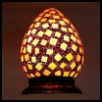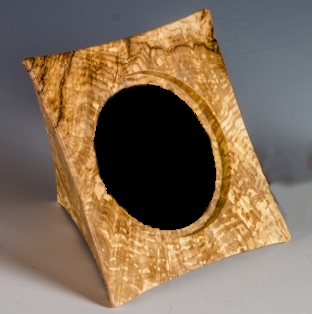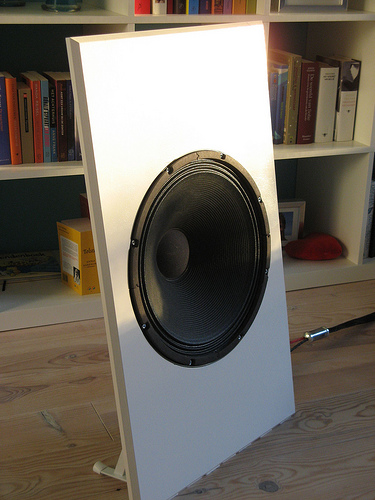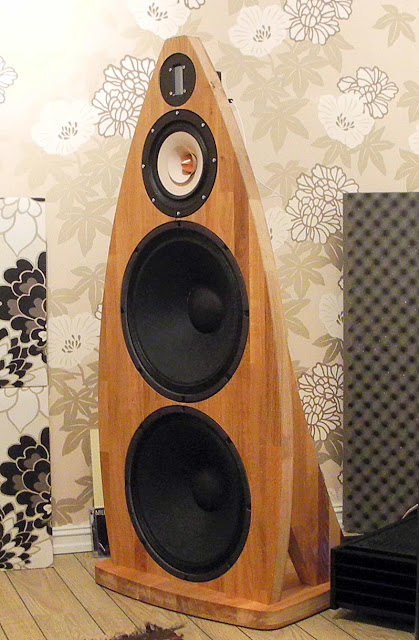Box Enclosures. Infinite Baffles
The closed box (acoustic suspension) and the vented box (bass reflex)
cabinets are common designs for multi-way speakers. These designs can be applied
to single full range drivers but their effectiveness depends on the nature of
the driver. Some drivers such as Mitsubishi/Diatone 610, the Hammer Dynamics,
and some Fostex drivers have enough cone excursion so that they work well in box
cabinets (usually vented/bass reflex).
Diatone/Mitsubishi
The Diatone kit EIFL offers is made of particle board. It is similar
to the
JPO Memorial (made by Wavelength Audio), I guess, although smaller. A
project is based on Mitsubishi's original plans, and is quite
complicated; essentially, it uses a box of 1/2" birch plywood inside
another box
of 5/8" plywood; the two boxes are separated by wooden floorboards, one
to a
side. In the original Mitsubishi plan, the "inside box" does not extend
to the
front panel; but it does include the rear panel. The French guy didn't
follow
the rear part exactly - in fact, in his plan, the rear panel is
removable!
Damping is supposed to be natural wool.
This box design originated with Hiroyasu Kondo (Audio Note Japan) and the scans are from
l'Audiophile. The enclosure is designed specifically for the Diatone 610 in 8 or
16 Ohm. The low end should extend to 40Hz or so. I suspect that a Pioneer PM-16
Memorial should work too.
Fostex
Many Fostex drivers are suitable for closed or vented boxes, including the
FX200 and the F200A. Fostex has many plans for vented box speakers on their
website for Fostex full range drivers.
David Weems
Bass reflex box (design by Weems) in an article using Radio Shack drivers in
Valve Magazine, Vol 6, No 4, 1999 at Bottlehead.com. Includes construction
plans.
Jordan
Ted Jordan has designed many great
full range drivers, the latest in the Jordan line include the JX-92S which can
be used in a vented box or transmission line. (Go to the Jordon website and click on Systems.
Rehd�ko
Info from Ulli (thanks). These loudspeakers are made by Rehd�ko in France.
There are three models: RK 115 has one 26 cm full-range driver, RK 125 has one
26 cm full-range driver and one elliptical tweeter (12 x 19 cm). The big RK 145
has one full-range woofer (26 cm), 1 high midrange (12 x 19 cm) with REHD�KO
"saucer", one elliptical tweeter (12 x 19 cm) with supra-dispersion (with the
famous REHD�KO "saucer"). Ulli has heard all three types and says that even the
smallest speaker sounds more natural than a Lowther DX in the Audiovector. Small
write ups appear at Enjoythemusic.com.
PHY-HP
PHY-HP in a baffle.
Lowther Bass Reflex Speakers
Lowther drivers need help in the bass region due to their strongly rising
frequency response. For a full range speaker, a rear-loaded horn is usually the
best option. Some people claim good results with Lowthers in bass reflex boxes,
while others who have tried or heard them find them terrible. If your room is
"live" and has lots of reinforcement in the bass region, or your music taste
doesn't require full volume bass, they might work. Some optimized vented box
might be better than poorly-designed or executed rear horns. In any case, you
will need to hear the loudspeaker in your room to get a genuine answer. Search
the AudioAsylum
archives (in Speaker Asylum and in High Efficiency Asylum) for "bass reflex"
and Lowther, or under "Classic Audio" to find a large amount of opinion
(informed or otherwise !).
Recently a review appeared here at Enjoythemusic.com
which was quite negative, and resulted in some discussion on the Full Range Driver Forum. (Search on
Dicks, or Classic Audio).
Full-range Driver & Loudspeaker Theory
Full-range (or wide-range) drivers come in two general types: the center cap
and the whizzer cone. The center cap type looks like your normal cone speaker
with a dome center cap. The whizzer cone type has two cones, a large cone (as in
normal cone speakers) and a smaller whizzer cone inside the large cone. Driver
units have quite different characteristics depending on the design and
manufacturer. Some (like Lowther) have very high efficiency, low excursion, and
a frequency response graph that shows lowered sound pressure levels at medium to
low bass (below 400 Hz). For this reason, to be an effective full range speaker,
these drivers usually need special cabinet construction designed to enhance the
bass output, such as a rear-loaded horn. However, the high efficiency allows the
use of very low power amplifiers (such as a two Watt 2A3 tube amp). Other
drivers have lower efficiency but flatter frequency response. These drivers can
often be used in an open baffle or bass reflex cabinet, but require higher
amplifier power to drive them.
There are very few true full range drivers that radiate from one source. The
Diatones almost qualify, but are a bit weak in the bass, and a little weak in
the highs. Some old drivers such as the Goodmans Axiom 80s, and maybe
Telefunkens and Norelcos and others go down to low bass (30s) and pretty high
(12 - 16 kHz) making them more full range. These all radiate "from the front
cone", making a true point source and having no or little time delay errors.
Finding or making these drivers is very difficult. Most "full-range" drivers end
up needing two radiation sources, one for low and one for high frequencies.
Lowther drivers, for example, radiate the high and mid frequencies from the
cone, but the bass come out of a horn and are delayed in time and 180 degrees
out of phase, as well as coming from the horn mouth rather than from the cone.
So in a way, you have two frequency sources, with a crossover between them. The
crossover is acoustic and needs to be tuned properly, and at the crossover
frequency there is still potential for interaction of the two wave fronts.
Another option with a Lowther-style radiator (which goes from high to mid
frequencies) is to add a separate bass system. Bert Doppenberg's Oris 150 front
horn for Lowthers needs a separate bass system, Bert uses bass horns with
dedicated drivers. Subwoofers might work but are often not "fast" enough to
integrate properly. This philosophy puts the (one) crossover at the low
frequencies (150 - 200 Hz for Bert's, approx 300 Hz for most rear-loaded Lowther
drivers).
Another philosophy puts the crossover frequency high up, at 12 kHz, or 15
kHz, the higher the better. This method uses a driver that runs from low bass
(30 or 40 Hz say) all the way up to the crossover frequency (10.5 kHz say), then
lets a supertweeter take over from there. The big question is, where is it
better to put a crossover? Low frequencies or high?
A second question is, what kind of bass do you like? Horn-loaded bass
(whether from a Lowther horn or a dedicated bass horn) is regarded as being
"fast", having good transient response characteristics, a very natural sound.
Direct radiators have a harder time making that kind of bass. Bass drivers with
long throws and polypropylene cones are particularly bad. A bass driver cone
made from paper (or sometimes kevlar or other modern material) often sounds
better. But a full-range driver such as a Diatone cannot have too large a
diaphragm and also cannot have too large a cone movement (xMax) because
otherwise high frequencies will be attenuated and intermodulation distortion
will result from the long throw. However, to make more bass, you can increase
the surface area (cone size) without increasing the travel (xMax). Now you can
have more bass and higher treble without too much intermodulation distortion, as
long as you can control the larger cone (need good design for the cone). With
the shorter travel, bass will become more controlled, crisper and more
responsive compared to a long travel bass driver. (You won't get as much bass
out, but it will sound nice).
Cone material can be made from paper (the classic material), plastic (often
polypropylene), synthetic fiber/resin such as kevlar, and metal (often
aluminium). Paper tends to have less stiffness than some other materials (kevlar
and metal) but doesn't exhibit the ringing resonance often found in kevlar and
metal. Some paper cones can be stiffened up with varnish-like substances such as
Damar. Good discussion on driver theory is by Bob Stout at LDSG. Some excellent
articles by Lynn Olson on The Art of Speaker
Design and speaker drivers (along with some tube thoughts).
Physics of Full Range Drivers
By John Wyckoff
Any attempt to explain full range cone-and-coil loudspeakers must begin with
the fact that there is no such thing. Rather, such drivers are systems of two or
more drivers on the same motor assembly. This may seem to be splitting hairs,
but it is a very important concept in understanding drivers designed to operate
full range. The two basic formats for full range drivers are whizzer cone and
center cap type. In either case, there is going to be a substantial peak in the
frequency response where the main cone and secondary device are both active.
This spike is most easily understood in the case of the central dome type
driver, such as the JBL LE8T-H. If a measurement is taken of the physical width
of the dome, and that measurement is then converted to a wavelength, it may be
seen that the co-resonance of the main cone and the dome is 6.1k Hz.. A
measurement microphone will confirm this. This spike is fairly narrow in Q, but
about +7 dB in height. A secondary resonance is created at the half wave point
as well, or where the dome equals one half of 3.05 kHz. This resonance is lower
in amplitude, and can be heard as "glare". In the case of the whizzer, or free
cone driver, the exact point of resonance is more difficult to find with a
ruler, but is still just as prevalent.
A free cone has many additional problems for the designer to overcome when
compared to a center cap type. Free cones have radiating surfaces which are not
in phase with each other, nor do the inner and outer surfaces receive the same
air loading ( I've measured free cones which have 90 degree phase shift). The
inside of the free cone is its own conical horn, while the outside is horn
loaded by the main cone, which is an entirely different horn formulation.
Anomalies also result from the outer edge of the free cone as the front and rear
waves collide along this diffractive edge.
When the above difficulties are added to the other resonances within the
driver; such as: fundamental resonance, cone resonance, and free-cone or dome
resonance, the design job begins to look impossible. While good quality
broadband drivers do exist, finding the right compromises is one of the most
difficult problems in audio. For example, if enough mass is added to the main
cone to reduce the cone resonance, the higher frequencies will be attenuated. If
the cone is too light, it probably won't be strong enough to act as much of a
piston at low frequencies. A driver which has enough excursion to offer dynamic
bass, will exhibit higher intermodulation distortion. Full range driver systems
are not a bass driver with a whizzer.
As mentioned before, there are more anomalies with the free cone approach
than with a central dome, yet free cones predominate. This is because they offer
much greater dispersion, and more adjustability. The Hammer Dynamics Super 12
drivers are of free cone and center dome design, to extend the bandwidth as much
as possible. This third device offers challenges of its own.
Many smaller broadband drivers (200mm and under) are rear loaded into horns,
in order to extend bass. There are several problems related to this type of
loading: Size, delay, coloration, and the fact that this approach is the
application of feedback. Striving to produce amplifiers without feedback, and
then introducing it into the speaker design, seems odd engineering.
Whizzer Cones by MG (from a Full Range Forum post)
Whizzer cones were originally an afterthought to extend the high frequency
response of midrange cones. Midrange paper cones absorb the flexural wave as it
travels out from the voice coil. This means that there is a reduction in
radiating area and high frequency response. Since the wave speed is proportional
to the square root of frequency this usually ends up being a 1st order roll off,
but please don't ask me to explain this in detail in a simple posting!
The midrange of paper cones can be extended by flaring the cone, so that the
centre is mildly horn loaded, this gets you up to about 5kHz. The whizzer is
flared to fit inside the main cone, and can sometimes be be used to horn load
the area between the whizzer and the cone. Normal DIY practice is to fiber wool
fill this region to avoid higher frequency cancellation.
By being light and stiff, the whizzer does not greatly affect the working of
the main cone, the flexural wave traveling out from the voice coil pretty much
unattenuated. This means that the high frequency can now be radiated over a much
larger area, and hence the response is extended. The front of the whizzer does
not horn load the centre, although the shape will affect high frequency
dispersion.
Since the whizzer is unconstrained around the edges some cone modes can
occur, although half roll surrounds do not damp these out as much as people
would like to believe. The best trick for this is to silicon fluid damp both
paper cones - since the whizzer is much thinner it will absorb much less silicon
fluid, so its high frequency response will not be greatly attenuated. Critical
damping of the spider is also very successful at eliminating these, but can
increase the mechanical damping Qms parameter.
Understanding of diaphragm flexure has led to a new generation of
whizzer-less full range designs, the pinnacle being the Jordan JX series. For my
money these represent the ultimate cone flexure technology, but there are many
other available drivers. Increasing practice is to use the same passive
electrical network, used for baffle step correction, to extend the high
frequency response - although this is limited to about 1/2 an octave.
End of Full range driver website information cited.
Open and Infinite Baffle Cabinets:
Truly Old School-- But to lower Diffraction Effects...
...consider a Hemisphere Shape for the Baffle
 +
  
| 







